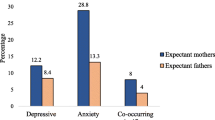Abstract
Purpose
To assess prevalence and risk factors for posttraumatic stress disorder (PTSD) and depression in fathers after early preeclampsia (PE) or preterm premature rupture of membranes (PPROM).
Methods
Partners of patients hospitalized for PE or PPROM and partners of healthy controls completed PTSD (PSS-SR) and depression (BDI-II) questionnaires during pregnancy (t 1) and 6 weeks postpartum (t 2). 85 of the 187 eligible men participated (51 partners of patients, 34 partners of control) at t 1, and 66 men participated both time points.
Results
No significant differences were found between partners of patients and partners of controls in symptoms of PTSD and depression (t 1: p = 0.28 for PTSD and p = 0.34 for depression; t 2: p = 0.08 for PTSD and p = 0.31 for depression). For partners of patients, correlation between PTSD and depression sum-scores was 0.48 (p < 0.001) at t 1 and 0.86 (p < 0.001) at t 2. Within-couple correlation was low and not significant during pregnancy, but strong at postpartum (PSS-SR: r = 0.62, p < 0.001; BDI-II: r = 0.59, p < 0.001). Higher paternal age was associated with more symptoms of PTSD and depression postpartum in partners of patients. Symptoms of PTSD and depression during pregnancy predicted the occurrence of PTSD symptoms following childbirth in partners of patients.
Conclusions
Symptoms of PTSD and depression occurred at a similar rate in partners of women with PE or PPROM and partners of healthy pregnant controls. Symptoms of PTSD and depression during pregnancy predicted the occurrence of PTSD symptoms following childbirth. Increased paternal age predicted more symptoms of PTSD and depression postpartum. At 6 weeks postpartum, a strong association was found between men and women in symptoms of PTSD and depression.

Similar content being viewed by others
References
Gavin NI, Gaynes BN, Lohr KN, Meltzer-Brody S, Gartlehner G, Swinson T (2005) Perinatal depression: a systematic review of prevalence and incidence. Obstet Gynecol 106(5):1071–1083
Ayers S, Joseph S, Kenzie-McHarg K, Slade P, Wijma K (2008) Post-traumatic stress disorder following childbirth: current issues and recommendations for future research. J Psychosom Obstet Gynaecol 29:240–250
Stramrood CA, Paarlberg KM, Huis In ‘t Veld EM, Berger LW, Vingerhoets AJ, Weijmar Schultz WC, van Pampus MG (2011) Posttraumatic stress following childbirth in homelike- and hospital settings. J Psychosom Obstet Gynaecol 32:88–97
Beck CT (2004) Post-traumatic stress disorder due to childbirth: the aftermath. Nurs Res 53:216–224
Parfitt YM, Ayers S (2009) The effect of post-natal symptoms of post-traumatic stress and depression on the couple’s relationship and parent-baby bond. J Reprod Infant Psychol 27:127–142
Bradley R, Slade P (2011) A review of mental health problems in fathers following the birth of a child. J Reprod Infant Psychol 29:19–42
Ramchandani PG, Stein A, O’Connor TG, Heron J, Murray L, Evans J (2008) Depression in men in the postnatal period and later child psychopathology: a population cohort study. J Am Acad Child Adolesc Psychiatry 47:390–398
Paulson JF, Dauber S, Leiferman JA (2006) Individual and combined effects of postpartum depression in mothers and fathers on parenting behavior. Pediatrics 118:659–668
Ramchandani P, Stein A, Evans J, O’Connor TG (2005) Paternal depression in the postnatal period and child development: a prospective population study. Lancet 365:2201–2205
Skari H, Skreden M, Malt UF, Dalholt M, Ostensen AB, Egeland T, Emblem R (2002) Comparative levels of psychological distress, stress symptoms, depression and anxiety after childbirth—a prospective population-based study of mothers and fathers. BJOG 109:1154–1163
Turton P, Badenhorst W, Hughes P, Ward J, Riches S, White S (2006) Psychological impact of stillbirth on fathers in the subsequent pregnancy and puerperium. Br J Psychiatry 188:165–172
Munk-Olsen T, Laursen TM, Pedersen CB, Mors O, Mortensen PB (2006) New parents and mental disorders: a population-based register study. JAMA 296:2582–2589
Pinheiro RT, Magalhaes PV, Horta BL, Pinheiro KA, da Silva RA, Pinto RH (2006) Is paternal postpartum depression associated with maternal postpartum depression? Population-based study in Brazil. Acta Psychiatr Scand 113:230–232
Iles J, Slade P, Spiby H (2011) Posttraumatic stress symptoms and postpartum depression in couples after childbirth: the role of partner support and attachment. J Anxiety Disord 25:520–530
Paulson JF, Bazemore SD (2010) Prenatal and postpartum depression in fathers and its association with maternal depression: a meta-analysis. JAMA 303:1961–1969
Goodman JH (2004) Paternal postpartum depression, its relationship to maternal postpartum depression, and implications for family health. J Adv Nurs 45:26–35
American Psychiatric Association (1994) Diagnostic and statistical manual of mental disorders. American Psychiatric Association , Washington, DC
Voges MA, Romney DM (2003) Risk and resiliency in post traumatic stress disorder. Ann Gen Hospital Psychiatry 2:4
Bradley R, Slade P, Leviston A (2008) Low rates of PTSD in men attending childbirth: a preliminary study. Br J Clin Psychol 47:295–302
Horowitz M, Wilner N, Alvarez W (1979) Impact of Event Scale: a measure of subjective stress. Psychosom Med 41:209–218
Ayers S, Wright DB (2007) Symptoms of post-traumatic stress disorder in couples after birth: association with the couple’s relationship and parent–baby bond. J Reprod Infant Psychol 25:40–50
Engelhard IM, van Rij M, Boullart I, Ekhart TH, Spaanderman ME, van den Hout MA, Peeters LL (2002) Posttraumatic stress disorder after pre-eclampsia: an exploratory study. Gen Hosp Psychiatry 24:260–264
Holditch-Davis D, Bartlett TR, Blickman AL, Miles MS (2003) Posttraumatic stress symptoms in mothers of premature infants. J Obstet Gynecol Neonatal Nurs 32:161–171
Kersting A, Dorsch M, Wesselmann U, Ludorff K, Witthaut J, Ohrmann P, Hornig-Franz I, Klockenbusch W, Harms E, Arolt V (2004) Maternal posttraumatic stress response after the birth of a very low-birth-weight infant. J Psychosom Res 57:473–476
Pierrehumbert B, Nicole A, Muller-Nix C, Forcada-Guex M, Ansermet F (2003) Parental post-traumatic reactions after premature birth: implications for sleeping and eating problems in the infant. Arch Dis Child Fetal Neonatal Ed 88:F400–F404
Hoedjes M, Berks D, Vogel I, Franx A, Visser W, Duvekot JJ, Habbema JD, Steegers EA, Raat H (2011) Symptoms of post-traumatic stress after preeclampsia. J Psychosom Obstet Gynaecol 32:126–134
Poel YH, Swinkels P, de Vries JI (2009) Psychological treatment of women with psychological complaints after pre-eclampsia. J Psychosom Obstet Gynaecol 30:65–72
van Pampus MG, Wolf H, Weijmar Schultz WC, Neeleman J, Aarnoudse JG (2004) Posttraumatic stress disorder following preeclampsia and HELLP syndrome. J Psychosom Obstet Gynaecol 25:183–187
Baecke M, Spaanderman ME, van der Werf SP (2009) Cognitive function after pre-eclampsia: an explorative study. J Psychosom Obstet Gynaecol 30:58–64
Stramrood CA, Wessel I, Doornbos B, Aarnoudse JG, Van den Berg PP, Weijmar Schultz WC, van Pampus MG (2011) Posttraumatic stress disorder following preeclampsia and PPROM: a prospective study with 15 months follow-up. Reprod Sci 18:645–653
Stramrood CA, Huis In ‘t Veld EM, van Pampus MG, Berger LW, Vingerhoets AJ, Weijmar Schultz WC, Van den Berg PP, Van Sonderen EL, Paarlberg KM (2010) Measuring posttraumatic stress following childbirth: a critical evaluation of instruments. J Psychosom Obstet Gynaecol 31:40–49
Foa EB, Riggs DS, Dancu CV, Rothbaum BO (1993) Reliability and validity of a brief instrument for assessing Post-traumatic stress disorder. J Trauma Stress 6:459–473
Beck AT, Steer RA, Brown GK (1996) Beck Depression Inventory Manual. The Psychological corporation, San Antonio
ACOG Committee on Practice Bulletins—Obstetrics (2002) ACOG practice bulletin. Diagnosis and management of preeclampsia and eclampsia. Number 33, January 2002. Obstet Gynecol 99:159–167
ACOG Committee on Practice Bulletins—Obstetrics (2000) Report of the national high blood pressure education program working group on high blood pressure in pregnancy. Am J Obstet Gynecol 183:S1–S22
ACOG Committee on Practice Bulletins—Obstetrics (2007) ACOG Practice Bulletin No.80. Premature rupture of membranes. Clinical management guidelines for obstetrician-gynecologists. Obstet Gynecol 109:1007–1019
Ahearn E (1997) The use of visual analogue scales in mood disorders: a critical review. J Psychiatr Res 31:569–579
Bond AJ, Shine P, Bruce M (1995) Validation of visual analogue scales in anxiety. Int J Methods Psychiatric Res 5:1–9
McCormack HM, Horne DJ, Sheather S (1988) Clinical applications of visual analogue scales: a critical review. Psychol Med 18:1007–1019
Reips U-D, Funke F (2008) Interval-level measurement with visual analogue scales in internet-based research: VAS generator. Behav Res Methods 40:699–704
Wohlfarth TD, van den Brink W, Winkel FW, ter Smitten M (2003) Screening for posttraumatic stress disorder: an evaluation of two self-report scales among crime victims. Psychol Assess 15:101–109
Beck AT, Steer RA, Ball R, Ranieri W (1996) Comparison of Beck depression inventories -IA and -II in psychiatric outpatients. J Pers Assess 67:588–597
Steer RA, Brown GK, Beck AT, Sanderson WC (2001) Mean Beck Depression Inventory-II scores by severity of major depressive episode. Psychol Rep 88:1075–1076
Aalto AM, Elovainio M, Kivimaki M, Uutela A, Pirkola S (2012) The Beck Depression Inventory and General Health Questionnaire as measures of depression in the general population: a validation study using the Composite International Diagnostic Interview as the gold standard. Psychiatry Res 197:163–171
Warmenhoven F, van Rijswijk E, Engels Y, Kan C, Prins J, van Weel C, Vissers K (2012) The Beck Depression Inventory (BDI-II) and a single screening question as screening tools for depressive disorder in Dutch advanced cancer patients. Support Care Cancer 20:319–324
Bosscher RJ, Koning H, van Meurs R (1986) Reliability and validity of the Beck Depression Inventory in a Dutch college population. Psychol Rep 58:696–698
Soderquist J, Wijma B, Thorbert G, Wijma K (2009) Risk factors in pregnancy for post-traumatic stress and depression after childbirth. BJOG 116:672–680
Wang SY, Chen CH (2006) Psychosocial health of Taiwanese postnatal husbands and wives. J Psychosom Res 60:303–307
Matthey S, Barnett B, Ungerer J, Waters B (2000) Paternal and maternal depressed mood during the transition to parenthood. J Affect Disord 60:75–85
Dudley M, Roy K, Kelk N, Bernard D (2001) Psychological correlates of depression in fathers and mothers in the first postnatal year. J Reprod Infant Psychol 19:187–202
Cox JL, Holden JM, Sagovsky R (1987) Detection of postnatal depression. Development of the 10-item Edinburgh Postnatal Depression Scale. Br J Psychiatry 150:782–786
Matthey S, Barnett B, Kavanagh DJ, Howie P (2001) Validation of the Edinburgh Postnatal Depression Scale for men, and comparison of item endorsement with their partners. J Affect Disord 64:175–184
Kessler RC, Sonnega A, Bromet E, Hughes M, Nelson CB (1995) Posttraumatic stress disorder in the National Comorbidity Survey. Arch Gen Psychiatry 52:1048–1060
Patten S (2009) Accumulation of major depressive episodes over time in a prospective study indicates that retrospectively assessed lifetime prevalence estimates are too low. BMC Psychiatry 9:19
Breslau N, Davis GC, Andreski P, Peterson EL, Schultz LR (1997) Sex differences in posttraumatic stress disorder. Arch Gen Psychiatry 54:1044–1048
White T, Matthey S, Boyd K, Barnett B (2006) Postnatal depression and post-traumatic stress after childbirth: prevalence, course and co-occurrence. J Reprod Infant Psychol 24:107–120
Gottvall K, Waldenstrom U (2002) Does a traumatic birth experience have an impact on future reproduction? BJOG 109:254–260
Acknowledgments
This research was supported by an Innovational Research Incentive VIDI grant (452-03-329) of the Foundation for Behavioural and Educational Sciences of the Netherlands Organization for Scientific Research (NWO) awarded to I. W.
Conflict of interest
We declare that we have no conflict of interest.
Author information
Authors and Affiliations
Corresponding author
Rights and permissions
About this article
Cite this article
Stramrood, C.A.I., Doornbos, B., Wessel, I. et al. Fathers with PTSD and depression in pregnancies complicated by preterm preeclampsia or PPROM. Arch Gynecol Obstet 287, 653–661 (2013). https://doi.org/10.1007/s00404-012-2611-0
Received:
Accepted:
Published:
Issue Date:
DOI: https://doi.org/10.1007/s00404-012-2611-0




